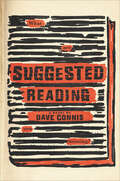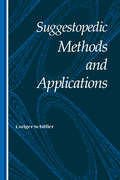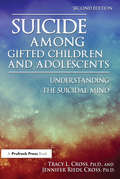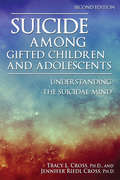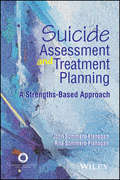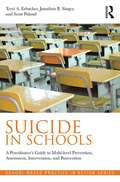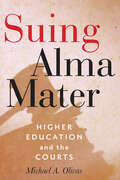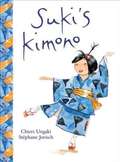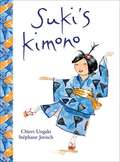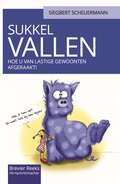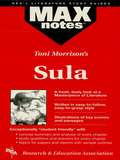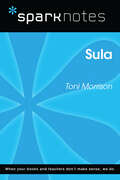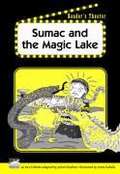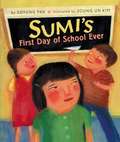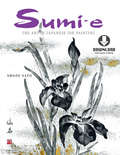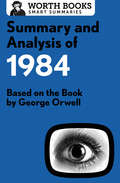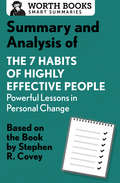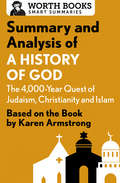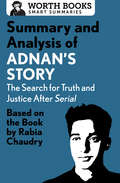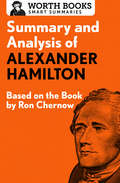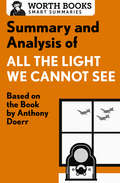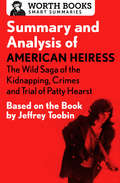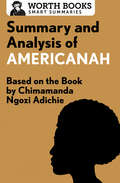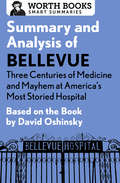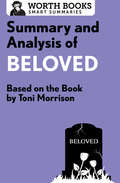- Table View
- List View
Suggested Reading: A Novel
by Dave ConnisIn this hilarious and thought-provoking contemporary teen standalone that’s perfect for fans of Moxie, a bookworm finds a way to fight back when her school bans dozens of classic and meaningful books.Clara Evans is horrified when she discovers her principal’s “prohibited media” hit list. The iconic books on the list have been pulled from the library and aren’t allowed anywhere on the school’s premises. Students caught with the contraband will be sternly punished.Many of these stories have changed Clara’s life, so she’s not going to sit back and watch while her draconian principal abuses his power. She’s going to strike back.So Clara starts an underground library in her locker, doing a shady trade in titles like Speak and The Chocolate War. But when one of the books she loves most is connected to a tragedy she never saw coming, Clara’s forced to face her role in it. Will she be able to make peace with her conflicting feelings, or is fighting for this noble cause too tough for her to bear?“Suggested Reading is a beautiful reminder that there is nothing simple about loving a book.” —David Arnold, New York Times bestselling author of Mosquitoland
Suggestopedic Methods/Applicat
by SchifflerFirst Published in 1992. Routledge is an imprint of Taylor & Francis, an informa company.
Suicide Among Gifted Children and Adolescents: Understanding the Suicidal Mind
by Tracy L. Cross Jennifer Riedl CrossThe updated second edition of Suicide Among Gifted Children and Adolescents explores the suicidal behavior of students with gifts and talents. It provides the reader with a coherent picture of what suicidal behavior is; clarifies what is known and what is unknown about it; shares two major theories of suicide with explanatory power; and offers an emerging model of the suicidal behavior of students with gifts and talents. In addition, the book includes chapters offering insight into the lived experience of students with gifts and talents, and what we can do to prevent suicide among gifted students, including creating caring communities and specific counseling strategies. It also provides a list of resources available to help.
Suicide Among Gifted Children and Adolescents: Understanding the Suicidal Mind
by Tracy CrossThe updated second edition of Suicide Among Gifted Children and Adolescents explores the suicidal behavior of students with gifts and talents. It provides the reader with a coherent picture of what suicidal behavior is; clarifies what is known and what is unknown about it; shares two major theories of suicide with explanatory power; and offers an emerging model of the suicidal behavior of students with gifts and talents. In addition, the book includes chapters offering insight into the lived experience of students with gifts and talents, and what we can do to prevent suicide among gifted students, including creating caring communities and specific counseling strategies. It also provides a list of resources available to help.
Suicide Assessment and Treatment Planning: A Strengths-Based Approach
by John Sommers-Flanagan Rita Sommers-FlanaganThis practical guide provides a holistic, wellness-oriented approach to understanding suicide and working effectively with clients who are suicidal. John and Rita Sommers-Flanagans’ culturally sensitive, seven-dimension model offers new ways to collaboratively integrate solution-focused and strengths-based strategies into clinical interactions and treatment planning with children, adolescents, and adults. Each chapter contains diverse case studies and key practitioner guidance points to deepen learning in addition to a wellness practice intervention to elevate mood. Personal and professional self-care and emotional preparation techniques are emphasized, as are ethical issues, counselor competencies, and clinically nuanced skill building. “This engaging book provides considerable insight into the dynamics around suicide, the emotional distress involved, and how counselors can best assist clients while also focusing on their own health and wellness. The Sommers-Flanagans’ strengths-based approach will allow practitioners to connect with their clients and offer understanding and hope when they are most needed.” —Kelly Duncan, PhD, LPC ACES Executive Director “I will read anything that the Drs. Sommers-Flanagan write. This book, however, is one where I took my time and savored each page. Why? Because suicide is emotionally charged, societally and individually taboo, scary, and near the top of the list of more common and feared client experiences. This book treats suicide assessment and treatment in an intelligent, thoughtful, and practical way for clients and clinicians. It humanizes suicidal ideation and, in doing so, helps the reader better understand how to truly care for those in distress.” —Matt Englar-Carlson, PhD California State University, Fullerton About the Authors John Sommers-Flanagan, PhD, is a professor of counseling at the University of Montana and the author or coauthor of more than 100 professional publications. Rita Sommers-Flanagan, PhD, is a professor emerita of counseling at the University of Montana. She is a psychologist, poet, blogger, and the author or coauthor of almost as many publications as John. *Requests for digital versions from ACA can be found on www.wiley.com *To purchase print copies, please visit the ACA website here <div style="margin: 0px; padding: 0px; user-select: text; -webkit-user-drag: none; -webkit-tap-highlight-color: transparent; overflow: visible; cursor: text; clear: both; position: relative; direction: ltr; font-
Suicide in Schools: A Practitioner's Guide to Multi-level Prevention, Assessment, Intervention, and Postvention (School-based practice in action series)
by Scott Poland; Jonathan B. Singer; Terri A. ErbacherThe authors include detailed case examples, innovative approaches for professional practice, usable handouts, and internet resources on the best practice approaches to effectively work with youth who are experiencing a suicidal crisis as well as those students, families, school staff, and community members who have suffered the loss of a loved one to suicide.
Suing Alma Mater: Higher Education and the Courts
by Michael A. OlivasThis careful reading of six legal cases in American higher education is an essential primer for understanding contemporary litigation.Winner of the Steven S. Goldberg Award for Distinguished Scholarship in Education Law of the Education Law AssociationAlthough much has been written about U.S. Supreme Court decisions involving higher education, little has been said about the foundational case law and litigation patterns emerging from the lower courts. As universities become increasingly legislated, regulated, and litigious, campuses have become testing grounds for a host of constitutional challenges. From faculty and student free speech to race- or religion-based admissions policies, Suing Alma Mater describes the key issues at play in higher education law.Eminent legal scholar Michael A. Olivas considers higher education litigation in the latter half of the twentieth century and the rise of "purposive organizations," like the American Civil Liberties Union and the Alliance Defense Fund (now known as the Alliance Defending Freedom), that exist to advance litigation. He reviews more than 120 college cases brought before the Supreme Court in the past fifty years and then discusses six key cases in depth. Suing Alma Mater provides a clear-eyed perspective on the legal issues facing higher education today.
Suki's Kimono
by Chieri UegakiSuki's favorite possession is her blue cotton kimono. A gift from her obachan, it holds special memories of her grandmother's visit last summer. And Suki is going to wear it on her first day back to school -- no matter what anyone says. <P><P>When it's Suki's turn to share with her classmates what she did during the summer, she tells them about the street festival she attended with her obachan and the circle dance that they took part in. In fact, she gets so carried away reminiscing that she's soon humming the music and dancing away, much to the delight of her entire class! Filled with gentle enthusiasm and a touch of whimsy, Suki's Kimono is the joyful story of a little girl whose spirit leads her to march -- and dance -- to her own drumbeat.
Suki's Kimono (Into Reading, Read Aloud Module 1 #3)
by Chieri Uegaki Stéphane JorischNIMAC-sourced textbook <P><P>Suki's favorite possession is her blue cotton kimono. A gift from her obachan, it holds special memories of her grandmother's visit last summer. And Suki is going to wear it on her first day back to school --- no matter what anyone says. <P><P>When it's Suki's turn to share with her classmates what she did during the summer, she tells them about the street festival she attended with her obachan and the circle dance that they took part in. In fact, she gets so carried away reminiscing that she's soon humming the music and dancing away, much to the delight of her entire class! <P><P>Filled with gentle enthusiasm and a touch of whimsy, Suki's Kimono is the joyful story of a little girl whose spirit leads her to march --- and dance --- to her own drumbeat. <P><P>Lexile Measure: 690L
Sukkelvallen: hoe u van lastige gewoonten af geraakt.
by Siegbert ScheuermannBoekbeschrijving. Dit boek houdt u een humoristische spiegel voor, waarmee u beter uw gewoonten en aangeboren gedragspatronen kan herkennen. Welke daarvan verminderen uw levenskwaliteit en hoe kan u hier van af geraken ? U wil bvb. regelmatig sporten, gewicht afvallen of ophouden met roken, maar uw brein verzint telkens weer redenen om ’s morgens toch wat langer te blijven liggen, dat kleine stukje chocolade als een uitzondering te beschouwen of uw carrière als niet-roker voor u uit te schuiven ? Ten laatste vanaf veertig zijn wij niet alleen voor ons gewicht, maar ook voor ons uiterlijk en onze houding verantwoordelijk. Gewoonten nestelen zich in ons denken, onze relaties, gezichtsuitdrukkingen en lichaamsvormen. De eerste stappen om zich te bevrijden : 1ste stap : een bestand opmaken in de zoo van onze “gewoontediertjes”. 2de stap : gewoonten en gedragspatronen analyseren. 3de stap : hoe vervangt u vervelende gewoonten in positieve ? Vaststellingen : Ons brein is dikwijls een uitstekende rechtvaardigingsmachine, zodat alles zijn vertrouwde “gang” kan gaan. We moeten niet proberen onze innerlijke demonen te verslaan maar hen eerder uitnodigen ten dans en met hen rondjes draaien. Bevrijd u van uw valstrikken, van naïviteit, incompetentie, onwetendheid, inconsequentie en schadelijke identificaties. Verheug u op uren leesplezier, zij zullen u ten goede komen ! De inhoud is ontstaan op basis van persoonlijke ervaringen en het houden van gedrags- en communicatietraining gedurende 25 jaar met duizenden deelnemers. Aan de basis liggen de artikelen van de auteur verschenen in de blog : www.hirnschrittmacher.eu
Sula (MAXNotes Literature Guides)
by Anita Price DavisREA's MAXnotes for Toni Morrison's Sula MAXnotes offer a fresh look at masterpieces of literature, presented in a lively and interesting fashion. Written by literary experts who currently teach the subject, MAXnotes will enhance your understanding and enjoyment of the work. MAXnotes are designed to stimulate independent thought about the literary work by raising various issues and thought-provoking ideas and questions. MAXnotes cover the essentials of what one should know about each work, including an overall summary, character lists, an explanation and discussion of the plot, the work's historical context, illustrations to convey the mood of the work, and a biography of the author. Each section of the work is individually summarized and analyzed, and has study questions and answers.
Sula (SparkNotes Literature Guide Series)
by SparkNotesSula (SparkNotes Literature Guide) by Toni Morrison Making the reading experience fun! Created by Harvard students for students everywhere, SparkNotes is a new breed of study guide: smarter, better, faster. Geared to what today's students need to know, SparkNotes provides: *Chapter-by-chapter analysis *Explanations of key themes, motifs, and symbols *A review quiz and essay topicsLively and accessible, these guides are perfect for late-night studying and writing papers
Sumac and the Magic Lake
by Anne Flounders Anita Dufalla Jackie GlasthalPerform this Inca folktale about an emperor who offers a reward to anyone who can bring water back from a far-away magic lake.
Sumi's First Day of School Ever
by Soyung PakFrom the author of the Ezra Jack Keats Award winner "Dear Juno" comes this thoughtful picture book about a young Korean girl on her first day of school. It can be tough when you are different and at a new school. By the time Sumi finishes her first day of school, she decides that school is not as lonely, scary, or mean as she had thought.
Sumi-e
by Shozo SatoIn this eagerly awaited treasury, renowned Japanese master Shozo Sato offers his own personal teaching on the beautiful art of sumi-e. Sumi-e: The Art of Japanese Ink Painting provides step-by-step, photo-by-photo instructions to guide learners in the correct form, motions and techniques of Japanese sumi-e painting. <P><P> Featuring gorgeous images and practical advice, it includes guided instructions for 35 different paintings. From waterfalls to bamboo, learners paint their way to understanding sumi-e-a style of painting that is characteristically Asian and has been practiced for well over 1,000 years. Although it's sometimes confused with calligraphy, as the tools used are the same, sumi-e instead tries to capture the essence of an object or scene in the fewest possible strokes. <P> This all-in-one resource also provides a timeline of brush painting history, a glossary of terms, a guide to sources and an index-making it a tool to use and treasure, for amateurs and professionals alike. This sumi-e introduction is ideal for anyone with a love of Japanese art or the desire to learn to paint in a classic Asian style.
Summary and Analysis of 1984: Based on the Book by George Orwell (Smart Summaries)
by Worth BooksSo much to read, so little time? This brief overview of 1984 tells you what you need to know—before or after you read George Orwell&’s book. Crafted and edited with care, Worth Books set the standard for quality and give you the tools you need to be a well-informed reader. This short summary and analysis of 1984 includes: Historical contextChapter-by-chapter overviewsCharacter analysisImportant quotesFascinating triviaGlossary of termsSupporting material to enhance your understanding of the original work About 1984 by George Orwell: George Orwell&’s classic novel 1984 is a cautionary tale about a dystopian society under the crushing and watchful eye of a tyrannical regime led by Big Brother. The dark story revolves around Winston Smith, an everyman who is tired of the government&’s lies and relentless persecution of people who dare think for themselves. He manages to find the strength to stand up to a totalitarian system and, in the process, finds love and affection in a world where both have been deemed obsolete. Originally published in 1949, Orwell&’s 1984 is a masterpiece of modern fiction and one of the most enduring and influential books of the twentieth century. The summary and analysis in this ebook are intended to complement your reading experience and bring you closer to a great work of fiction.
Summary and Analysis of 7 Habits of Highly Effective People: Based on the Book by Steven R. Covey (Smart Summaries)
by Worth BooksSo much to read, so little time? This brief overview of The 7 Habits of Highly Effective People tells you what you need to know—before or after you read Stephen Covey&’s book. Crafted and edited with care, Worth Books set the standard for quality and give you the tools you need to be a well-informed reader. This short summary and analysis of The 7 Habits of Highly Effective People includes: Historical contextChapter-by-chapter overviewsProfiles of the main charactersDetailed timeline of key eventsImportant quotesFascinating triviaGlossary of termsSupporting material to enhance your understanding of the original workAbout The 7 Habits of Highly Effective People by Stephen Covey: One of the most popular and enduring works of personal-growth literature, international bestseller The 7 Habits of Highly Effective People offers life-changing insights. More than a book about business management, The 7 Habits of Highly Effective People takes readers through a tiered process of change that begins from the inside and moves outward. Stephen Covey inspires readers to reexamine their core values, discover their personal mission, and interact in more meaningful ways. Covey provides strategies for personal effectiveness that have helped millions of people around the world live more effective, fulfilling lives. The summary and analysis in this ebook are intended to complement your reading experience and bring you closer to a great work of nonfiction.
Summary and Analysis of A History of God: Based on the Book by Karen Armstrong (Smart Summaries)
by Worth BooksSo much to read, so little time? This brief overview of A History of God tells you what you need to know—before or after you read Karen Armstrong&’s book. Crafted and edited with care, Worth Books set the standard for quality and give you the tools you need to be a well-informed reader. This short summary and analysis of A History of God by Karen Armstrong includes: Historical contextChapter-by-chapter summariesDetailed timeline of important eventsImportant quotesFascinating triviaSupporting material to enhance your understanding of the original work About A History of God by Karen Armstrong: A History of God is a rich and comprehensive account of the concept of God across thousands of years of human history. Karen Armstrong, a former nun, focuses on Judaism, Christianity, and Islam, with insights into the work of Western history&’s great theologians and philosophers. Can humanity persist without some idea of God? Far from moving into an era of pure atheism, Armstrong believes that God as a construct is more crucial now than ever. God is not &“dead,&” God has not abandoned us, God merely shape-shifts to adapt to new contexts, whether that context is medieval agrarianism, nineteenth-century romanticism, or twenty-first-century post-modern techno-urbanism. Armstrong&’s in-depth examination of monotheism provides a foundation for the curious novice while not holding back on academic concepts and obscure but fascinating historical accounts. The summary and analysis in this ebook are intended to complement your reading experience and bring you closer to a great work of nonfiction.
Summary and Analysis of Adnan's Story: Based on the Book by Rabia Chaudry
by Worth BooksSo much to read, so little time? This brief overview of Adnan's Story tells you what you need to know--before or after you read Rabia Chaudry's book. Crafted and edited with care, Worth Books set the standard for quality and give you the tools you need to be a well-informed reader. This short summary and analysis of Adnan's Story by Rabia Chaudry includes: Historical contextChapter-by-chapter summariesDetailed timeline of key eventsProfiles of the main charactersImportant quotesFascinating triviaGlossary of termsSupporting material to enhance your understanding of the original work About Adnan's Story by Rabia Chaudry: By listening to the wildly popular, award-winning podcast Serial, readers may be familiar with the case against Adnan Syed, alleged to have murdered his ex-girlfriend Hae Min Lee in 1999. But Serial didn't tell the whole story. In the New York Times bestseller Adnan's Story, author, lawyer, and Syed family friend Rabia Chaudry presents compelling new information, dismantling the state's case against Adnan Syed, one piece of evidence at a time. The summary and analysis in this ebook are intended to complement your reading experience and bring you closer to a great work of nonfiction.
Summary and Analysis of Alexander Hamilton: Based on the Book by Ron Chernow
by Worth BooksSo much to read, so little time? This brief overview of Alexander Hamilton tells you what you need to know--before or after you read Ron Chernow's book. Crafted and edited with care, Worth Books set the standard for quality and give you the tools you need to be a well-informed reader. This short summary and analysis of Alexander Hamilton by Ron Chernow includes: Historical contextChapter-by-chapter summariesDetailed timeline of key eventsImportant quotesFascinating triviaGlossary of termsSupporting material to enhance your understanding of the original work About Alexander Hamilton by Ron Chernow: Ron Chernow's New York Times-bestselling biography of Alexander Hamilton sets the record straight on the often-misunderstood founding father. Beginning with a thoroughly researched investigation of Hamilton's controversial origins, the book takes an immersive look at the man who authored the Federalist Papers, fought in the Revolutionary War, crafted the nation's financial system, and served as George Washington's right-hand man before being killed in an infamous duel with Aaron Burr. More than a portrait of one man, Alexander Hamilton is the story of America's birth--and the inspiration for Lin-Manuel Miranda's Pulitzer Prize-winning Broadway musical. The summary and analysis in this ebook are intended to complement your reading experience and bring you closer to a great work of nonfiction.
Summary and Analysis of All the Light We Cannot See: Based on the Book by Anthony Doerr (Smart Summaries)
by Worth BooksSo much to read, so little time? This brief overview of All the Light We Cannot See tells you what you need to know—before or after you read Anthony Doerr&’s book. Crafted and edited with care, Worth Books set the standard for quality and give you the tools you need to be a well-informed reader. This short summary and analysis of All the Light We Cannot See includes: Historical contextChapter-by-chapter overviewsProfiles of the main charactersThemes and symbolsImportant quotesFascinating triviaGlossary of termsSupporting material to enhance your understanding of the original work About All the Light We Cannot See by Anthony Doerr: Anthony Doerr&’s Pulitzer Prize–winning novel is a beautifully crafted story about the intersection of two very different lives: A German boy with a knack for radios and a blind girl in occupied France are somehow united as Europe is plunges into World War II. An ambitious and symbolic tale spanning eighty years, All The Light We Cannot See illiminates how goodness and hope can be found even in the darkest of times. The summary and analysis in this ebook are intended to complement your reading experience and bring you closer to a great work of fiction.
Summary and Analysis of American Heiress: Based on the Book by Jeffrey Toobin
by Worth BooksSo much to read, so little time? This brief overview of American Heiress tells you what you need to know--before or after you read Jeffrey Toobin's book. Crafted and edited with care, Worth Books set the standard for quality and give you the tools you need to be a well-informed reader. This short summary and analysis of American Heiress by Jeffrey Toobin includes: Historical contextChapter-by-chapter summariesDetailed timeline of key eventsProfiles of the main charactersImportant quotesFascinating triviaGlossary of termsSupporting material to enhance your understanding of the original work About American Heiress by Jeffrey Toobin: Bestselling author Jeffrey Toobin's American Heiress is a thorough true crime account of the kidnapping and trial of Patty Hearst, whose sensational journey gripped the nation and defined a tumultuous period in American history. On February 4, 1974, Patricia Hearst--the heiress to the Hearst family fortune--was abducted by a group of left-wing revolutionaries called the Symbionese Liberation Army (SLA). What started as a media sensation turned into a circus when a recording was released in which Patty claimed she was joining the movement and her new name was Tania. Set against the backdrop of an already turbulent era, and based on hundreds of interviews and never-before-seen documents, American Heiress is a revelatory look at one of the most famous abductions of the twentieth century. The summary and analysis in this ebook are intended to complement your reading experience and bring you closer to a great work of nonfiction.
Summary and Analysis of Americanah: Based on the Book by Chimamanda Ngozi Adichie (Smart Summaries)
by Worth BooksSo much to read, so little time? This brief overview of Americanah tells you what you need to know before or after you read Chimamanda Ngozi Adichie&’s book. Crafted and edited with care, Worth Books set the standard for quality and give you the tools you need to be a well-informed reader. This short summary of Americanah by Chimamanda Ngozi Adichie includes: Chapter-by-chapter overviewProfiles of the main charactersThemes and symbolsA note on the author&’s styleImportant quotesFascinating triviaSupporting material to enhance your understanding of the original work About Chimamanda Ngozi Adichie&’s Americanah: Spanning more than two decades and three countries, Chimamanda Ngozi Adichie&’s critically acclaimed novel is an astonishingly frank and multilayered work of literature that shines a harsh light on issues of race, class, feminism, and identity. Told from the perspective of two young Nigerians living abroad, Americanah is part love story and part unapologetic commentary on society and the immigrant experience. Honest, witty, revealing, and inspirational, Americanah is a unique and bold examination of what it means to be black in America. The summary and analysis in this ebook are intended to complement your reading experience and bring you closer to a great work of fiction.
Summary and Analysis of Bellevue: Based on the Book by David Oshinsky (Smart Summaries)
by Worth BooksSo much to read, so little time? This brief overview of Bellevue tells you what you need to know—before or after you read David Oshinsky&’s book. Crafted and edited with care, Worth Books set the standard for quality and give you the tools you need to be a well-informed reader. This short summary and analysis of Bellevue includes: Historical contextChapter-by-chapter overviewsCharacter profilesDetailed timeline of key eventsImportant quotes and analysisFascinating triviaGlossary of termsSupporting material to enhance your understanding of the original workAbout Bellevue: Three Centuries of Medicine and Mayhem at America&’s Most Storied Hospital by David Oshinsky: Pulitzer Prize–winning historian David Oshinsky provides a comprehensive account of New York City&’s famous Bellevue Hospital, from its early inception as a poorhouse infirmary to its most recent struggles and triumphs, including a dramatic evacuation during Hurricane Sandy and the successful treatment of an Ebola patient. In the centuries between, the hospital contends with epidemics ranging from yellow fever to AIDS, a meddling journalist named Nellie Bly, and the tragic murder of a doctor on hospital grounds by a mental patient. Some of Bellevue&’s finest staff are highlighted, including two doctors who operated on American presidents and two others who virtually invented forensic science. The history of Bellevue is the history of New York City, in all of its complicated and controversial glory, and its mission to serve the underprivileged is a fulfillment of the duty inscribed on the Statue of Liberty: &“Give me your tired, your poor, your huddled masses.&” The summary and analysis in this ebook are intended to complement your reading experience and bring you closer to a great work of nonfiction.
Summary and Analysis of Beloved: Based on the Book by Toni Morrison
by Worth BooksSo much to read, so little time? This brief overview of Beloved tells you what you need to know—before or after you read Toni Morrison’s book. Crafted and edited with care, Worth Books set the standard for quality and give you the tools you need to be a well-informed reader. This short summary and analysis of Beloved by Toni Morrison includes: Historical contextChapter-by-chapter summariesCharacter analysisThemes and symbolsFascinating triviaImportant quotesSupporting material to enhance your understanding of the original work About Beloved by Toni Morrison: A Nobel laureate and winner of the Pulitzer Prize, Toni Morrison weaves a heartbreaking tale of legendary proportions. Set in post–Civil War Ohio, Beloved is the story of an escaped slave haunted by her past. Although Sethe is no longer enslaved, she is not yet free from her memories of the child and husband she buried, of the brutal violence on the plantation she fled, of life and of death, and of everything in between. Beautiful, unflinching, and profound, Beloved is Morrison’s crowning achievement and is one of America’s greatest novels. The summary and analysis in this ebook are intended to complement your reading experience and bring you closer to a great work of fiction.
